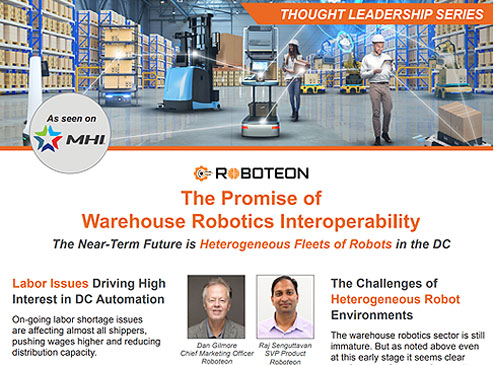Powering Warehouse Automation with Autonomous Mobile Robots

In this blog, we discuss why Autonomous Mobile Robots (AMRs) are drawings strong interest, including flexibility, scalability, ROI and more.
But we note it is the software that really drives AMR success and ROI, with capabilities varying widely across vendors, and robust robotic software platforms gaining market momentum.
Interest in warehouse automation generally, and robotics more specifically, is at very high levels, driven by continued distribution labor challenges and rising costs, cycle-time pressures, and more. Within the broader category of warehouse robotics, Autonomous Mobile Robots (AMR), are seeing widespread adoption - and with good reason.
According to ABI Research, the global installed base of AMRs in warehouses will surpass 500,000 by 2030.
What is an AMR?
An AMR, as the name suggests, is a robot that autonomously (i.e., without human intervention) navigates its way around the warehouse floor to perform various tasks, from basic transport functions to collaborative picking and more.
AMRs leverage a variety of sensors and vision systems that work with the vendor’s Fleet Management System (FMS) software to perceive the distribution center floor in real-time. This enables the AMRs to intelligently navigate around obstacles as they run routes or “missions" based on tasks sent from a software system.
This happens in part from the robot initially moving around the DC to record a digital map of the facility’s layout. Several technology advancements, including AI, enable AMRs to seamlessly move in the most efficient way, depending on conditions, to travel from point A to point B, and avoid collisions as they perform various tasks.
AMRs come in a wide variety of styles and options, depending on the vendor, including the capacity to move different payloads, and to offer different “accessories” such as carts for picking that move on the AMRs.
AMRs provide flexibility in warehouse automation and can support various use cases. For example, in a goods-to-person scenario, stationary pickers occupy workstations, to which AMRs delivery inventory from various locations. Associates then select items from the AMR for placement into shipping containers, usually supported by a “light” system that visually indicates to associates the work to be done. After all the picks from a given AMR are complete, it leaves, and another AMR arrives at the work station for more picks.
The high current interest in AMRs is driven by several factors:
- AMRs often allow more work to be completed with the same number of associates, increasing productivity while addressing labor shortage.
- While AMRs support several use cases, in distribution the focus is usually around various types of order picking, which for most companies is of course the highest cost process in the operation.
- AMRs provide deployment flexibility, allowing companies to start small if desired and add more robots over time with success and learnings.
- No single point of failure – if a robot goes down, there is generally little impact on the operation, unlike some other types of automation where a failure can stop all or most processing.
- As with other types of automation, warehouse robots can work multiple shifts, don’t call in sick, etc.
- Several studies have reported a significant return on investment (ROI) seen from AMR deployments
Another attraction is that some AMR vendors operate on a “Robots-as-a-Service” model in which the AMRs are not purchased up front but rather provided on a subscription basis for a monthly fee per robot deployed. This reduces upfront investment levels and allows distributors with high levels of seasonality to scale up with more robots for say a few months of the year in the peak season, and then return to normal levels for the rest of the year.
Getting the Software Right
Not surprisingly, companies considering AMRs in distribution tend to focus on the robots themselves, and less on the software that drives their operation.
This is a mistake, as the software is often the key factor in achieving rapid time-to-value, maximizing productivity and throughput, and ultimately achieving project success. The software that comes from robot OEMs themselves varies widely, from providing just the core functions of a Fleet Management Systems (warehouse mapping, travel navigation, and collision avoidance) to some basic picking and task management functions.
However, a robotic software platform, such as that provided by Roboteon, can offer a lot more, including:
- Interoperability across robots of different types and vendors with a unified user interface across all types of hardware
- Pre-built, robotic-enabled application workflows, such as piece and case picking, and many others
- Orchestration of order fulfillment across automated and non-automated processes
- Advanced execution capabilities in areas such as order clustering, order batching, task assignment to robots and humans, and more
- Synchronization of human and robotic resources to maximize efficiency and utilization
- Use of AI for continuous improvements in execution, data analytics, and more
- Modeling and Simulation tools to drive optimal tactical and strategic robotics decision-making
Time to Take a Look at AMRs?
It is clear that interest in and adoption of Autonomous Mobile Robots is growing rapidly. This is for a variety of good reasons, including flexibility, scalability, new pricing models, and of course ROI. According a 2023 Gartner Survey, 92% of companies currently use or plan to use robotics (including AMRs) to drive automation.
To maximize your results, however, we encourage you to take a deep look at the robotic software capabilities provided by different vendors.
Among the questions to consider: What capabilities do they have? How is interoperability supported? How will integration with the WMS or ERP be achieved? What fulfillment applications are available? How is AI leveraged? How are humans and robot resources synchronized? More…
We are confident the Roboteon Robotics Fulfillment Platform will stand up well from such an analysis. We would welcome the chance to show you why, or discuss your opportunities with one of our subject matter experts.
FEATURED BLOG

Roboteon’s Raj Senguttuvan Quoted Extensively in Article on Orchestration of ASRS and AMRs
READ MORENEWS
Roboteon and Stellium announce Strategic Partner Partnership for Robotics and Automation Solutions for SAP EWM using Roboteon’s Multi-Agent Orchestration Platform
LEARN MOREMeet Roboteon at SAP Sapphire in Orlando
LEARN MOREWell-Known Former Gartner Analyst Dwight Klappich Joins Roboteon as Strategic Advisor
LEARN MOREResources

Thought Leadership Series: The Promise of Warehouse Robotics Interoperability
DOWNLOAD REPORT
Understanding Warehouse Robotics Software - White Paper
DOWNLOAD REPORT
Roboteon Solution Overview
Watch Video